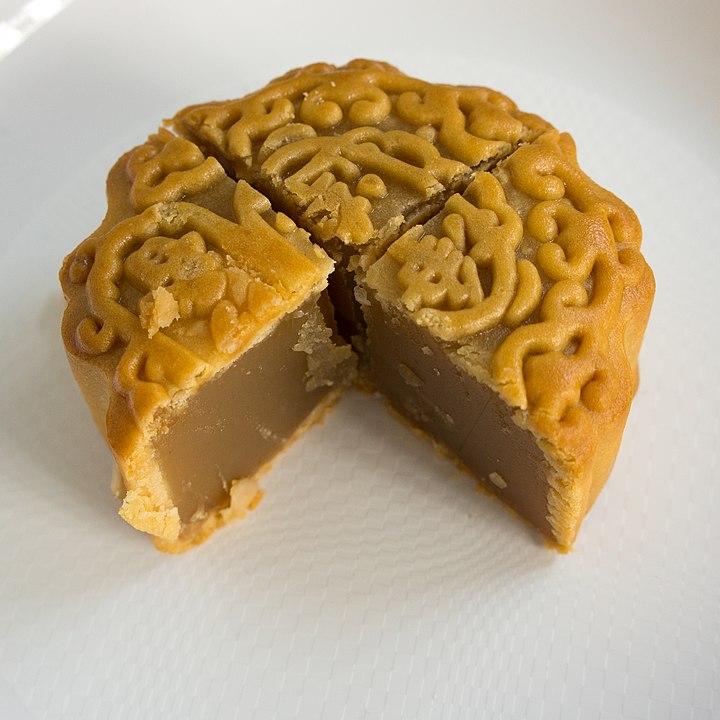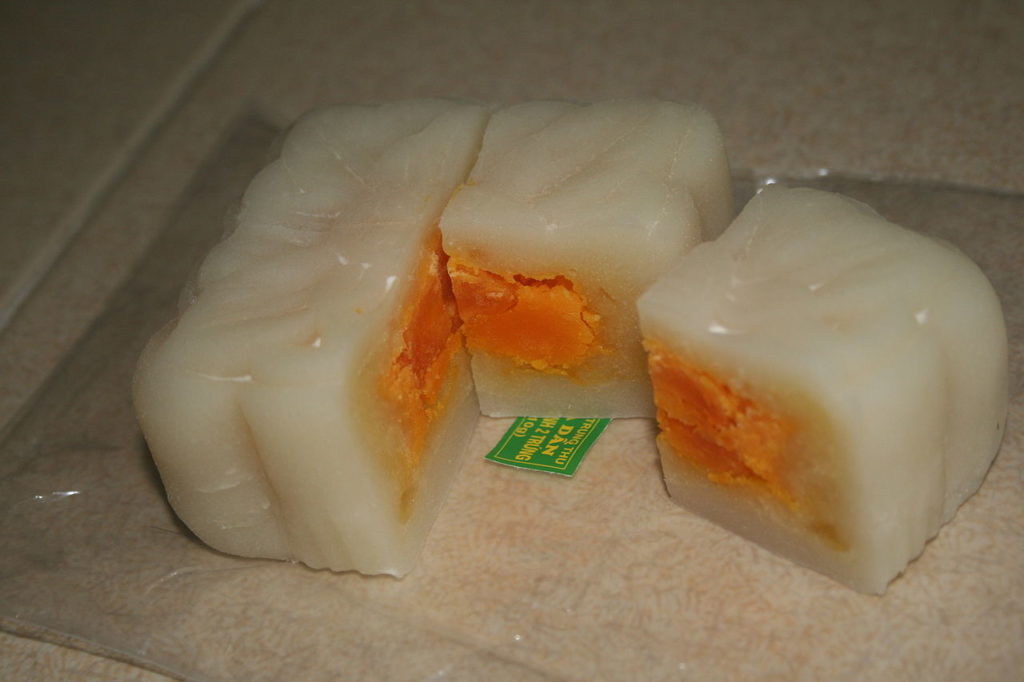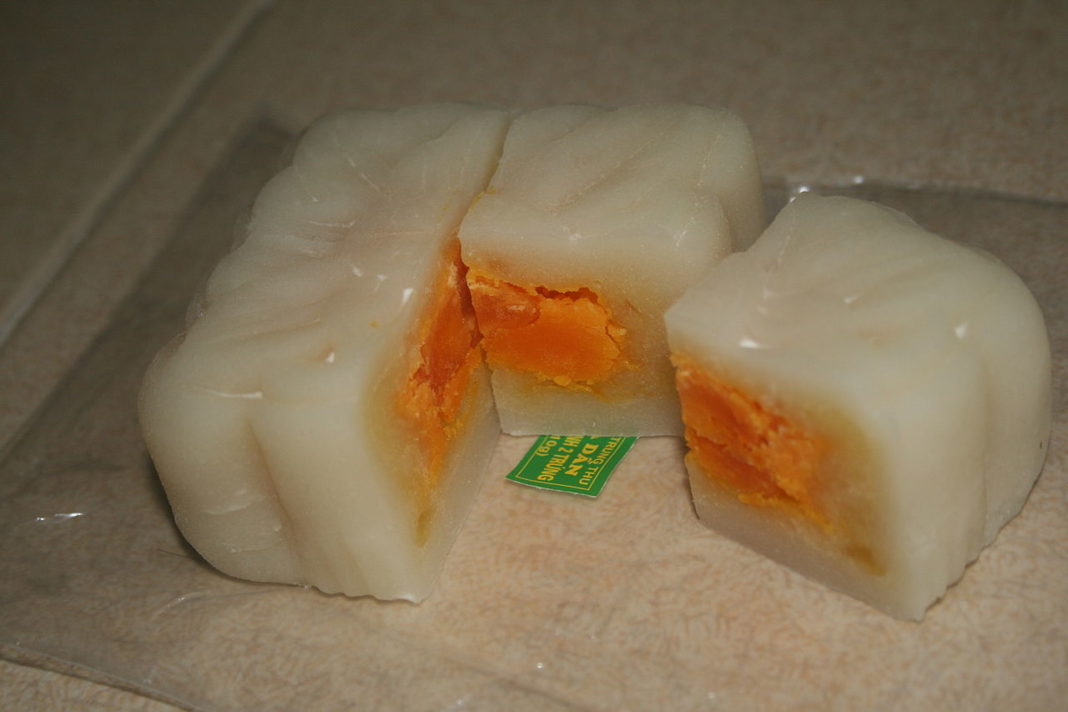But did you know there are other types of mooncake made by different Chinese dialect groups and even other countries, each with their own unique designs and fillings?
Check out some of the alternative mooncake options you can find in Southeast Asia.
1. Teochew mooncakes
There are several variants of Teochew mooncake, with Chaoshan-style being the most common one.
The round mooncake is known for its delicate layers of flaky crust, which can also be infused with different colours to create vibrant, colourful pastries.
It is typically filled with sweetened yam, mung bean or black bean paste, and may also have a salted egg yolk in the middle.
Traditional Teochew mooncakes, however, take a simpler form. Called la bia or “lard biscuit”, the pastry has a thin flaky crust made of lard and is filled with a thick mung bean or red bean paste.
 It also comes in a larger, flatter variant that is filled with tangerine peel, sugar and five-spice powder and encrusted with sesame seeds.
It also comes in a larger, flatter variant that is filled with tangerine peel, sugar and five-spice powder and encrusted with sesame seeds.
Yet another type of Teochew mooncake is the la gao, a steamed black sesame cake. It can either be served plain or with a mung bean or yam paste filling.
Chaoshan-style mooncakes and la bia can be found at a number of bakeries and specialty biscuit shops in the region, such as Thye Moh Chan in Singapore and Ching Han Guan in Ipoh, Malaysia.
2. Hokkien mooncake
Also known as “scholar cakes”, the pastry is historically given to scholars sitting for Imperial examinations in ancient China.
The flattish mooncake – which comes in different sizes – has an almost pure white skin resembling the moon and often carries a red stamp with Chinese characters on top.
The filling consists of candied winter melon, tangerine peel, melon seeds, sugar and lard, with sesame seeds sprinkled on top of the pastry. There’s also a savoury variant stuffed with minced meat that’s uncommon nowadays.
Hokkien mooncakes are still sold at bakeries and specialty biscuit shops like Poh Guan Cake House and Neo Kian Guan Confectionery in Singapore, as well as Khim Heong Biscuit Factory and Ching Han Guan Biscuits in Malaysia.
 3. Hainanese mooncake
3. Hainanese mooncake
The Hainanese mooncake is characterised by its distinctive blend of nutty and subtly spicy flavours, thanks to its unique filling.
Also known as su yan bing or “salt and pepper cakes”, the flaky pastry is stuffed with a filling made from fried onions, lard, rose-flavoured white sugar, sesame seeds, melon seeds and tangerine peel, flavoured with salt and pepper.
Ironically, this type of mooncake cannot be found in Hainan, China. It was created by Nam Tong Lee, a Hainanese confectionery in Singapore, in the 1920s as a cheaper alternative to Cantonese mooncakes.
Although the confectionery is no longer in business, a handful of bakeries in Singapore still make these uniquely local mooncakes, including Chuan Ji Bakery Hainanese Delicacies and Amethyst Pastry & Cakes.
4. Hakka moonlight cake
Traditionally used as offerings to the moon during the Mid-Autumn Festival, the Hakka moonlight cake is relatively unknown in this region compared to the other types of mooncakes.
Primarily made of glutinous rice flour and sugar, the flat, disc-like cake typically features intricate carvings of flowers and animals on top. Fillings, if any, usually consist of candied winter melon, desiccated coconut and sesame seeds mixed with glutinous rice flour, sugar, margarine and water.
5. Vietnamese sticky rice mooncake
In addition to the usual baked mooncakes, there’s another kind of mooncake in Vietnam called banh deo (sticky rice mooncake).
 With a texture similar to snow skin mooncakes, it is usually made from roasted glutinous rice flour, pomelo blossom water or vanilla and simple syrup.
With a texture similar to snow skin mooncakes, it is usually made from roasted glutinous rice flour, pomelo blossom water or vanilla and simple syrup.
The mooncakes are then stuffed with fillings that are similar to those of the baked variety, such as mung bean paste and salted egg yolk.
According to airasia.com














